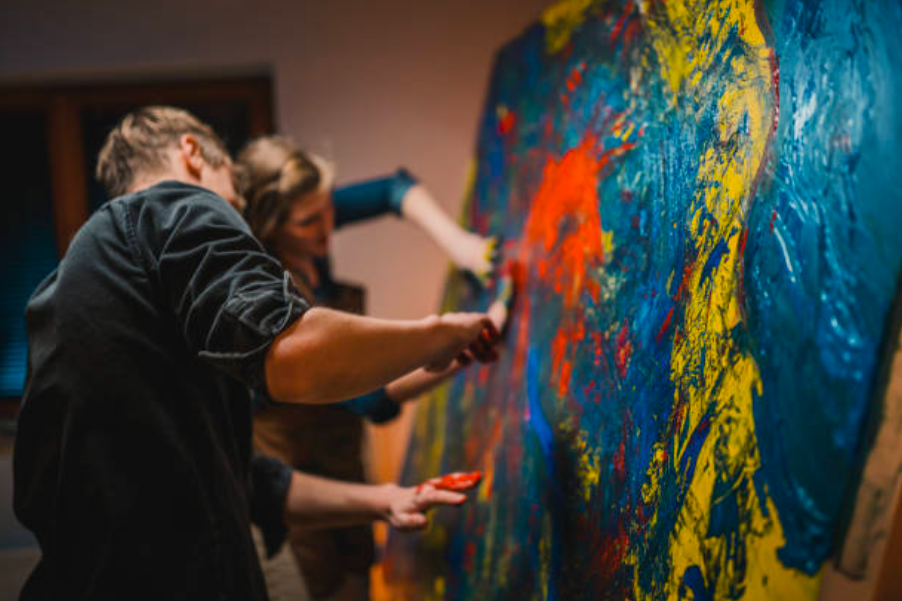
Everything You Need To Know About Acrylic On Canvas Artworks
Acrylic on canvas is a popular medium among artists. So, if you are new to it, then this guide will help you understand what it is, how it differs from other media, and how to care for your artworks.
What is Acrylic on Canvas?
Acrylic on canvas refers to a painting technique in which acrylic paint is applied onto a canvas surface. Naturally, acrylic paint is a fast-drying, water-soluble paint made from a synthetic polymer that is used as a binder.
There are three ingredients to the paint:
- Pigment, comprising small ground down solid particles that are suspended in the paint - these give the paint its colour.
- Acrylic binder is a polymer that holds the pigment in place and forms a protective film once the paint dries.
- Water, the acrylic vehicle to keep the paint liquid for the painting process, forming a polymer emulsion when combined with the binder. The water evaporates as the paint dries, forming a stable, coloured, water resistant film.
The paint is popular among artists due to its versatility and fast-drying properties. The canvas can be of different textures and sizes, and the painting technique allows for a range of styles, from thick impasto textures to smooth washes of color. Its elasticity means, even when fully dried, it resists cracking and flaking in a range of environmental conditions. This is why acrylic on canvas is a popular medium for contemporary artists due to its durability and flexibility.
How does Acrylic on Canvas Differ from Other Media?
Advantages
- Fast-Drying: Acrylic paint dries quickly, enabling artists to work faster and layer colors more seamlessly.
- Compared to other paints, acrylic paint is one of the more versatile mediums. Acrylic paint can be applied to a variety of surfaces, including canvas, paper, wood, and plastic, among others, provided there is no wax or oil on it.
- It is also water-soluble. Acrylic paint can be diluted with water to create a more transparent wash or used with full strength to create bold, vibrant colors. This also makes it easier for artists to wash off their hands, provided they do so before it dries.
- For the last advantage, acrylic paint is resistant to fading, cracking, and yellowing, making it ideal for artworks meant to last for years. Once dry, it is water resistant.
Disadvantages
- Acrylic paint is not as traditionally textured. Unfortunately, compared to oil paint, acrylic paint may not offer as much textural depth.
- Acrylic paint can also be too quick-drying. While quick drying is an advantage in some cases, it can also be a disadvantage because it limits the blending time and artists need to work quickly.
- The colour darkens when it dries, making it harder for artists to achieve the colour they want.
- Lastly, it is also harder to blend. The rapid drying time of acrylic paints can make it harder to blend colours evenly.
How to Care for Acrylic on Canvas Artworks
Acrylic on canvas artworks require proper care and handling to ensure their longevity. Here are some tips:
- Keep artwork out of direct sunlight. Otherwise, acrylic paint may fade when exposed to UV light.
- Wipe off any dust with a soft, clean, dry cloth regularly.
- Avoid touching the surface of the artwork with bare hands as oils from skin can damage the paint over time.
- Store artwork in a cool, dry place away from moisture and humidity.
- If necessary, clean the artwork with a delicate solution of mild soap and distilled water. Avoid using any harsh chemicals or solvents.
Conclusion
Acrylic on canvas is a versatile medium suitable for a range of painting techniques. Although having some downsides, it remains an excellent choice for artists due to its fast-drying, water-soluble, and durable nature. To ensure the longevity of your Acrylic on canvas artworks, avoid exposing it to direct sunlight, keep it dry and clean, and store it properly.
Asian Contemporary Art Gallery has acrylic on canvas artworks available for purchase. Check it out using the filter search feature on our Artworks page.







